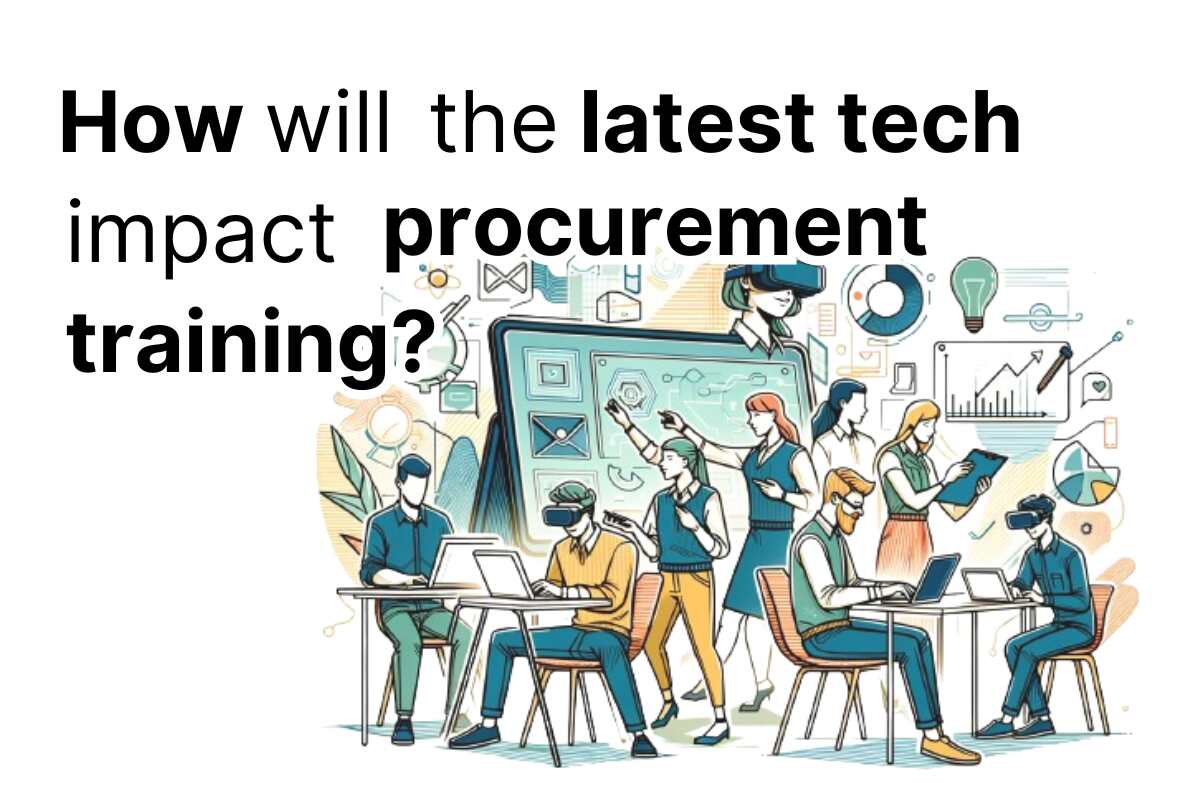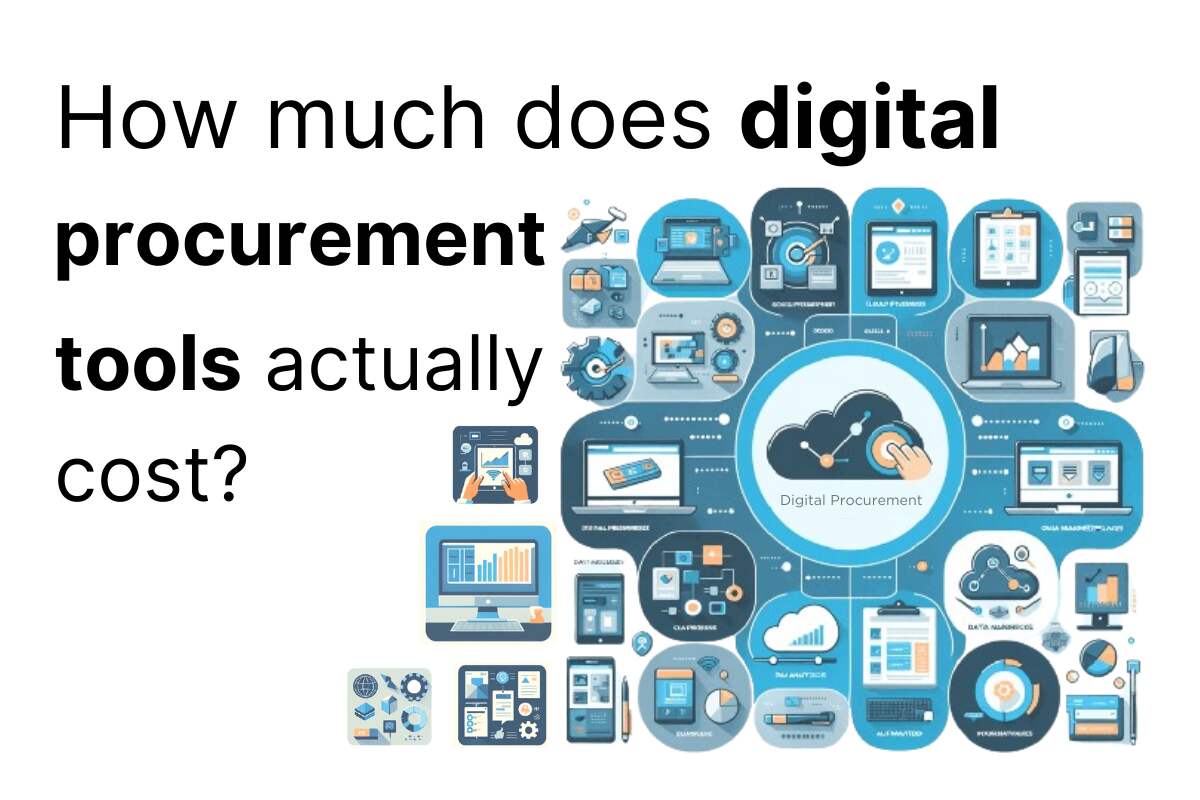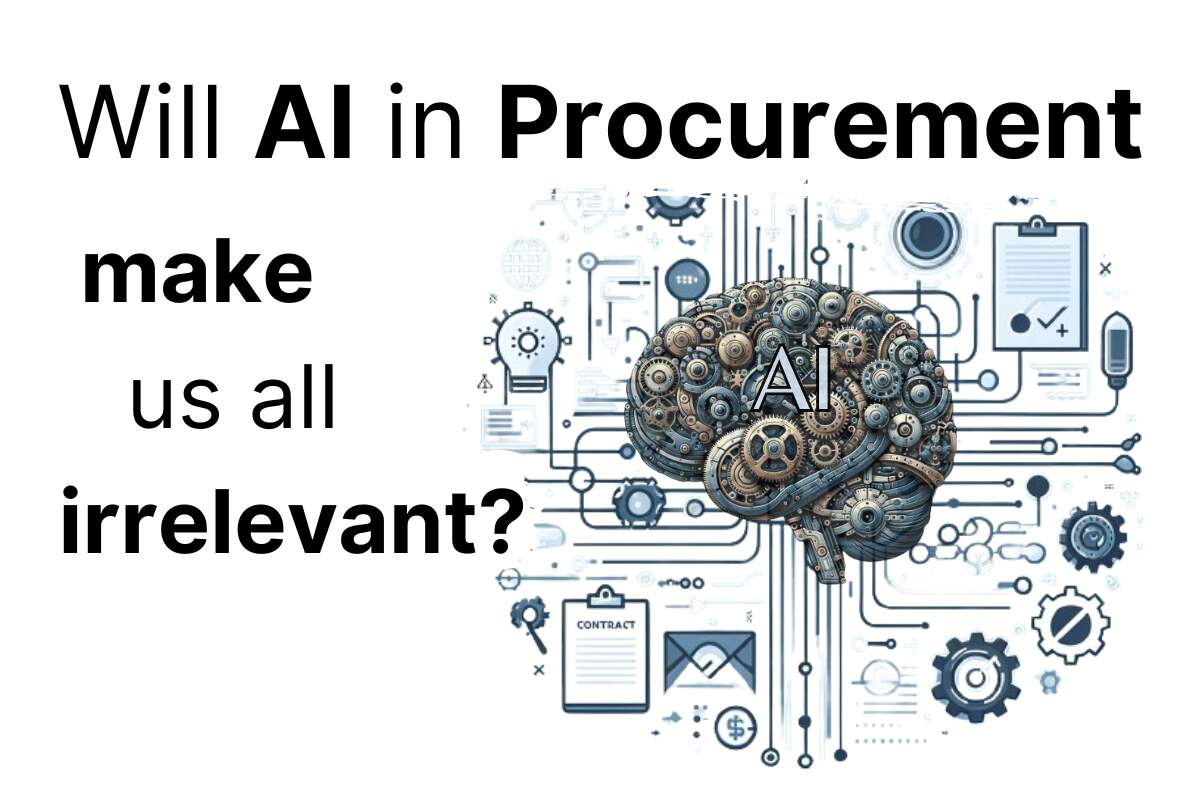When you hear the words Generative AI in Procurement, your reaction is probably one of two things:
Either you get excited, thinking of all the benefits and time-saving hacks it could offer. Or else, you sigh and roll your eyes, thinking it’s just the latest hype cycle.
There’s a valid argument both ways, but one thing is for sure. This technology is here to stay, in one form or another. We therefore must try to understand what potential impact generative AI could have on procurement organisations.
Traditional vs. Generative AI: What’s the difference?
Essentially, the main difference between traditional AI and generative AI is in their capabilities and application. Traditional AI systems are primarily used to train algorithms to analyse data and make predictions. Generative AI, on the other hand, goes a step further by creating new data similar to its training data.
As the technology develops and matures, many more use cases beyond just ChatGPT and Large Language Models (LLMs) will gain traction and become popular within everyday use. Gartner’s introductory guide to this topic provides a great overview.
Generative AI is a major step forward vs. “traditional” AI in part because of the simplicity of its user interfaces. Anyone who has used ChatGPT or Midjourney can confirm this. Its ability to create high-quality text or imagery in such a short period of time is mind-blowing.
If we let our minds run wild, it’s not difficult to see how much potential this technology could bring to transform many existing procurement processes and tasks.
Where are we now with Generative AI in Procurement?
The current state of Gen AI in procurement is best described as fragmented. There’s a lot of potential, but we’re not yet at the point where generative AI is routinely incorporated into the features of procurement tech applications.
We’ll get there soon, but we’re not there just yet.
There are plenty of tech providers experimenting with it. In a recent podcast interview I did with Sam Clive, Head of Product at data analytics platform Rosslyn, we looked at examples they had tested on spend data classification.
Sam explains that their spend classification results were historically very highly dependent upon the quality of their customer’s data. Through the trials they performed with generative AI, it has shown that poor customer data quality at line item level is no longer a significant obstacle to enabling correct data classification the first time.
There is a bright future ahead when we consider its potential, but we’re still in the early phases. It will take time before we have dedicated generative AI-driven procurement software. After that we’ll likely see enterprise-wide applications which can leverage its potential further.
Generative AI’s current impact in procurement is best illustrated by tech-savvy procurement category managers leveraging apps like ChatGPT and Bard to streamline the execution of routine tasks. Examples here are:
- Drafting routine RFP documents
- Non-disclosure agreements
- Frame contracts
- Procurement policies and procedures
So, in summary, the current use cases are more focused on time and efficiency savings. This is definitely a leap forward to free our time from routine work. However, the future potential is so much greater.
Which areas of Procurement could benefit from AI?
Let’s look at a few examples of use cases across common procurement technology applications.
Spend Analytics
As we showed in the example above, spend analytics can get a boost from using generative AI to assist with classification and taxonomy of free text purchase orders and vague descriptions.
Sourcing
When it comes to sourcing, AI can assist with RFX generation, reviewing supplier responses, and leveraging disparate, unstructured data into a coherent. It can also assist with supplier discovery and due diligence on potential new sources of supply. Through increased automation, generative AI will also bring more spend under management through tendering previously non-addressed spend.
P2P
This area already has lots of existing use cases for RPA and OCR throughout the requisition-to-receive and invoice-to-pay cycle. Generative AI will bolster this by reducing cycle time, automating transactions, and reducing non-compliance. A big potential area for increased automation will be with one-time spot buys.
Category Management
AI will increasingly be used to help to write and generate category strategies. Software applications such as Cirtuo and Capella are already offering guided category strategy creation. Alongside these, you’ve also got akirolabs which uses AI to consider wider data-driven business impact beyond category management.
SRM
The benefits here will likely be split into two distinct categories: evaluating supplier risk, and measuring supplier performance.
On the risk side, generative AI can digest market and media reports around external risk factors. It can also process disparate data sources and formulate these into predictive risk assessments.
Generative AI will also make it easy to automate requests for subjective feedback from stakeholders around supplier performance. In addition, it will be able to analyse date from different systems. This will enable an overall assessment of supplier performance, taking into account for example price, quality, delivery performance and sustainability metrics all in one.
Contract Management
We’re already seeing AI-driven redlining of contracts, and suggested clauses from inbuilt libraries in existing CLM software. Higher end CLM platforms are also already able to ingest an organisation’s complete portfolio of contracts and highlight where the highest risks or gaps are.
With contract management, the future is pretty much here now. Many mid to high-end CLM tools offer some of these features already.
What are the critical success factors?
Of course, it’s not as simple as buying some tech and then hoping and praying that adoption will be successful. There are certain prerequisites which must be in place, in order to ensure a successful introduction of generative AI into procurement teams.
Data
Data profiling, cleansing and leveraging good quality data is a key criteria for success. Adopting generative AI in procurement can revolutionise operations, offering tailored solutions, optimising costs, and speeding up decision-making. However, to successfully harness these benefits, you need a robust data strategy.
This strategy should focus on data quality, accessibility and security, ensuring AI systems have the right foundation to generate valuable insights and predictions. Without this groundwork, even the most advanced AI models can falter, resulting in inefficiencies or inaccuracies in the procurement processes downstream. A strategic, long-term approach and investment into data management is essential to fully leverage generative AI’s potential to transform procurement teams.
Talent
Integrating generative AI into procurement will unlock efficiencies, innovation and cost savings. Its success, however, hinges on hiring and developing and the right talent. Those who understand both strategic procurement practices as well as AI’s capabilities are crucial. They bridge the gap between technological potential and practical application, ensuring AI solutions are effectively tailored and implemented.
Without this expertise, organisations might not fully capitalise on the benefits, potentially leading to suboptimal results. Investing in talent development is therefore essential, enabling teams to sustain competitive advantage.
Technology
Legacy technology systems pose significant challenges. These outdated infrastructures often lack the flexibility and compatibility required to integrate advanced AI solutions. This could likely lead to integration difficulties and operational inefficiencies. The knock-on effect could then stifle innovation, slow down processes, and limit the ability to harness AI’s full potential for cost reduction, process optimisation, and decision-making enhancement.
To truly benefit from generative AI in procurement, organisations must either upgrade legacy systems or look to invest in more adaptable technologies.
What future benefits will generative AI in Procurement offer?
Let’s look at what is possible as we approach the future. With the full potential of generative AI and how this could deliver benefits, how will procurement be able to leverage this?
Better UX for stakeholders and suppliers
Internal stakeholders and suppliers alike will benefit from being able to leverage generative AI to improve access to information.
Through its ability to work with simple user interfaces and basic prompts, the user experience for transactional purchasing requirements will be vastly improved.
Over time, this will reduce the need to implement specialist P2P software for the purpose of improving UX for stakeholders and suppliers. Some examples of where generative AI can help, without the need to implement an expensive P2P suite include:
- Intake
- New supplier onboarding
- PO / delivery status
- Invoice payment status
Using prompts and receiving responses in plain language will reduce the need for suppliers or stakeholders to contact Buyers for routine enquiries.
Increased Productivity
Beyond transactional and operational procurement, generative AI offers many productivity advantages in routine, tactical tasks that are part of many strategic procurement activities.
In a recent article by Deloitte, they summarise this perfectly:
- Crunching large sets of data to reduce complex manual processes and interventions
- Leveraging complex automation to increase productivity and efficiency
- Generating actionable insights based on historic trends, demand profiles and supplier performance.
- Combining internal data with external data to craft better negotiation and category strategies.
Improved Compliance and Risk Management
This can be split into two distinct categories: supplier due diligence activities, and the mitigation of potential supply chain risk and disruption. Let’s look at each one separately.
Supplier Compliance and Due Diligence
Generative AI can help with the search, identification, evaluation and selection of potential suppliers. The benefit here comes from gen AI’s ability to analyse vast amounts of data from disparate sources.
For existing suppliers, compliance tasks can benefit from this technology too. AI can be used to track non-compliant spend, as well as monitoring potential fraudulent transactions. Generative AI can highlight anomalies and track activity against existing norms based on processes and procedures.
What humans with spreadsheets would not easily be able to manually keep track of, generative AI can with ease.
Mitigating Potential Supply Chain Risk and Disruption
Thanks to its ability to analyse large sets of past performance data, generative AI can predict and identify potential disruptions.
By marrying this with external data such as geopolitical risk, known supply chain disruptions, market intelligence, and news of extreme weather and natural disasters, this can all be leveraged to reduce the potential impact on a company’s manufacturing and distribution operations.
Joined-up Enterprise operating models
Generative AI’s ability to handle complex, unstructured text and data from disparate sources will enable more cross-departmental strategic collaboration. The constraints of data being stuck in legacy systems and siloed in departmental SharePoint sites can be overcome with gen AI technology.
Having access to upstream planning systems and operational performance metrics in real time will enable more accurate and data-driven supplier performance management.
How will Generative AI affect Jobs in Procurement?
We’ve spoken about the likely elimination of tactical and operational procurement roles previously, so I won’t dwell too much on this here.
What about strategic procurement roles though? How will generative AI affect Category Managers and Strategic Sourcing Leads?
I’ll give a short and simple answer.
For anyone who doesn’t enjoy the research and data crunching part of any strategic procurement role, it will feel liberating. That’s the good news – AI will be able to take a lot of the strain. The bad news is that there will likely be fewer category management and strategic sourcing positions in future to compensate for this.
If much of the data crunching and document generation can be done by AI, then Procurement will move to be more outwardly facing. Category management will increasingly become blurred with Procurement Business Partner-type roles as this job becomes more stakeholder-facing. Generative AI will take over a lot of the more inward-facing and data collection and analysis type of work. To work together with AI, we will see an increase in data scientist, data analyst, administrative and prompt engineer roles.
What’s a prompt engineer I hear you say? As generative AI develops beyond LLMs such as ChatGPT, the prompts will become more complex. Today, anyone reasonably smart with a bit of patience and the right thought process can get ChatGPT to write something pretty coherent. In future, this may not be so.
Prompt engineers, alongside more generalist admin assistants who can perform more simple tasks, will become an integral part of any procurement team.
Risks & Challenges
As we explored earlier on in the article, the risks of generative AI in procurement really stem from a lack of strategy and preparedness.
Bringing more spend under management is easily within reach, as is reducing fraud and improving supplier and stakeholder experience.
However, vision and the necessary investment in data cleansing is necessary to make it happen. Businesses who don’t invest time and resources into getting this right now will increasingly fall behind. Generative AI will likely increase the gap in performance and effectiveness of mature, data-driven and long-term thinking procurement teams. Organisations which are more reactive and short-termist in nature and who don’t invest in data, processes and people will increasingly suffer.
Aside from internal talent and data management challenges, there are also regulatory risks associated with generative AI.
What will come next?
A recent white paper from KPMG suggests that there will be three distinct phases of generative AI adoption in procurement teams:
1. Prompt-based use cases
This is pretty much where we’re at today. Savvy employees are already using prompts to support routine tasks and day-to-day work. Alongside this, tech providers are testing use cases of generative AI to enhance their current applications.
2. Adoption of generative AI into procurement software
There will be a wave of adoption into existing procuretech solutions, such as source-to-pay suites, spend analytics, e-sourcing and contract management software. Alongside this, we will also likely see the emergence of new solution providers with tech platforms built completely for and around generative AI. Similar to how best-of-breed solutions temporarily up-ended the suite providers, we will likely see something similar here.
3. Enterprise-wide applications
Exciting but also likely a way off yet, the future will be enterprise-wide use of generative AI to power cross-departmental strategic decision making. Instead of data being siloed with, say, Finance, Procurement, or Sales & Marketing, new generation platforms will be able to access these data sets across the whole enterprise. The result will be a massive potential reduction in both manual work and human error.


